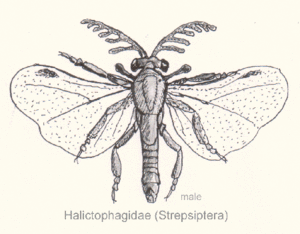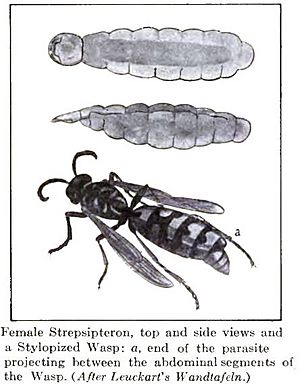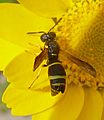Strepsiptera facts for kids
Quick facts for kids StrepsipteraTemporal range: Middle Cretaceous - Recent
|
|
|---|---|
 |
|
| male | |
 |
|
| Scientific classification | |
| Kingdom: | |
| Phylum: | |
| Class: | |
| Order: |
Strepsiptera
Kirby, 1813
|
Strepsiptera are a fascinating group of tiny insects, often called "twisted-wing parasites." There are about 600 known species of these small creatures. They are famous for their very unusual way of life: they live inside other insects!
Strepsipterans are parasites, meaning they live on or in another living thing (called a host) and get their food from it. Their hosts include planthoppers, leafhoppers, treehoppers, froghoppers, bees, and many other insects.
Contents
What Are Strepsiptera?
Strepsiptera are a special order of insects. They are quite small, often only a few millimeters long. They get their name, "twisted-wing," from the male's unique hindwings, which look a bit twisted when at rest.
Male Strepsiptera
Male Strepsiptera look very different from females. They have large, fan-shaped hindwings that they use to fly. Their front wings are tiny and club-shaped, almost like small stubs. Males also have big, bulging eyes that look a bit like raspberries, and antennae that are shaped like combs. They are free-living and only live for a short time, usually just a few hours or days. Their main job is to find a female to mate with.
Female Strepsiptera
Most female Strepsiptera are very different from the males. They are usually wingless and look like a small, soft sac. Many female Strepsiptera spend almost their entire lives inside the body of their host insect. Only a small part of their head and chest might stick out from the host's body. This makes them one of the most unusual insects on Earth!
Life Cycle and Parasitism
The life cycle of Strepsiptera is truly unique. It involves them living inside other insects.
How They Live Inside Hosts
When a female Strepsipteran is ready to lay eggs, she does so while still inside her host. The tiny larvae (baby insects) hatch inside the mother's body. These larvae are very active and have legs. They quickly leave the mother's body, often through a special opening, and look for a new host.
Once a larva finds a suitable host, it burrows inside. It then sheds its skin and changes into a legless, worm-like form. This is the stage where it lives and grows inside the host's body, feeding on its fluids.
Male Emergence
When a male Strepsipteran larva is fully grown, it pushes its way out of the host's body. It then forms a pupa, which is a resting stage, often with its head sticking out of the host. After a short time, the adult male emerges from the pupa. It quickly flies off to find a female.
Female Reproduction
A female Strepsipteran usually stays inside her host for her entire life. Only a small part of her body might be visible from the host's abdomen. Males find these females by sensing special chemicals (pheromones) they release. The male then mates with the female while she is still inside her host.
Images for kids
See also
 In Spanish: Estrepsípteros para niños
In Spanish: Estrepsípteros para niños




